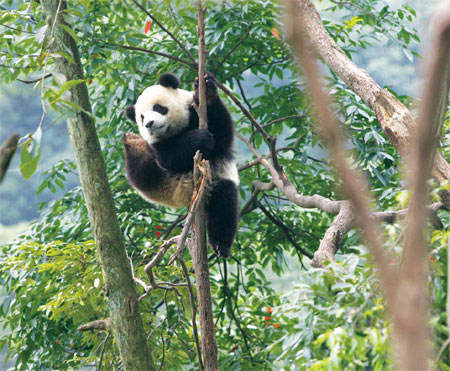Society
Wild training for captive pandas
By Zhao Yanrong (China Daily)
Updated: 2010-08-14 09:37
 |
Large Medium Small |
YA'AN, Sichuan - Experts have started to give captive giant pandas training on how to survive in the wild to improve their chances of survival when they are relocated. So far, no panda bred in captivity has survived being relocated.
|
 A panda shows off its tree-climbing skills at the nature reserve in Ya'an, Sichuan province, on Aug 9. [Cui Meng / China Daily] |
This includes teaching pandas how to seek food and to recognize their natural enemies' sounds and smells, the Chengdu Daily newspaper reported recently. The World Wildlife Fund says the panda's natural enemies are leopards and jackals.
The number of captive-bred pandas in the world recently broke the 300 mark after Na Na, from the Wolong panda center in Chengdu, in Sichuan province, gave birth last week. Some experts have said the captive-bred panda group is basically big enough to maintain their population and diversity by themselves.
"Wild pandas contribute only 20 percent to the diversity of giant pandas, while the group diversity has been well maintained in captivity," Gu said at a recent panda protection forum held in Ya'an, Sichuan province.
Gu said diversity is crucial for the continuation of species, and releasing more captive-bred pandas into the wild can help to keep its diversity and increase the population in general.
Gu was a member of the relocation team of the first captive-bred panda, Xiang Xiang, in 2006, a male who was beaten to death by other pandas within a year of being relocated.
"The possibility of successfully relocating pandas is higher for female pandas where other panda groups exist," he said.
Gu said another reason for relocating captive-bred pandas is that "mating between different groups" can improve the quality of offspring. Equipment such as surveillance cameras and tracing systems are also needed to monitor the relocated pandas.
"It is also important for the captive-bred pandas to have stronger fighting and survival capabilities in the wild," he said.
Zhu Lifeng, a researcher from the institute of zoology at the Chinese Academy of Sciences in Beijing, said the destruction of habitat is the biggest threat to wild pandas, as well as for those relocated.
"Even though people have stopped hunting pandas since the early 1980s, construction and farming activities in areas where wild pandas live have affected them," Zhu said.
For instance, two highways in Sichuan province have divided one of the biggest panda habitats in Qingling Mountains.
More than 100 vehicles drive through the area every hour, which has disrupted the movements of panda groups and prevented them from interacting. This has also resulted in wild pandas entering homes and farmlands seeking food such as farmed bamboo, a panda expert said on the forum.
"The protection of pandas and local residents' interests are both important, but how to find the balance is the crucial issue."



